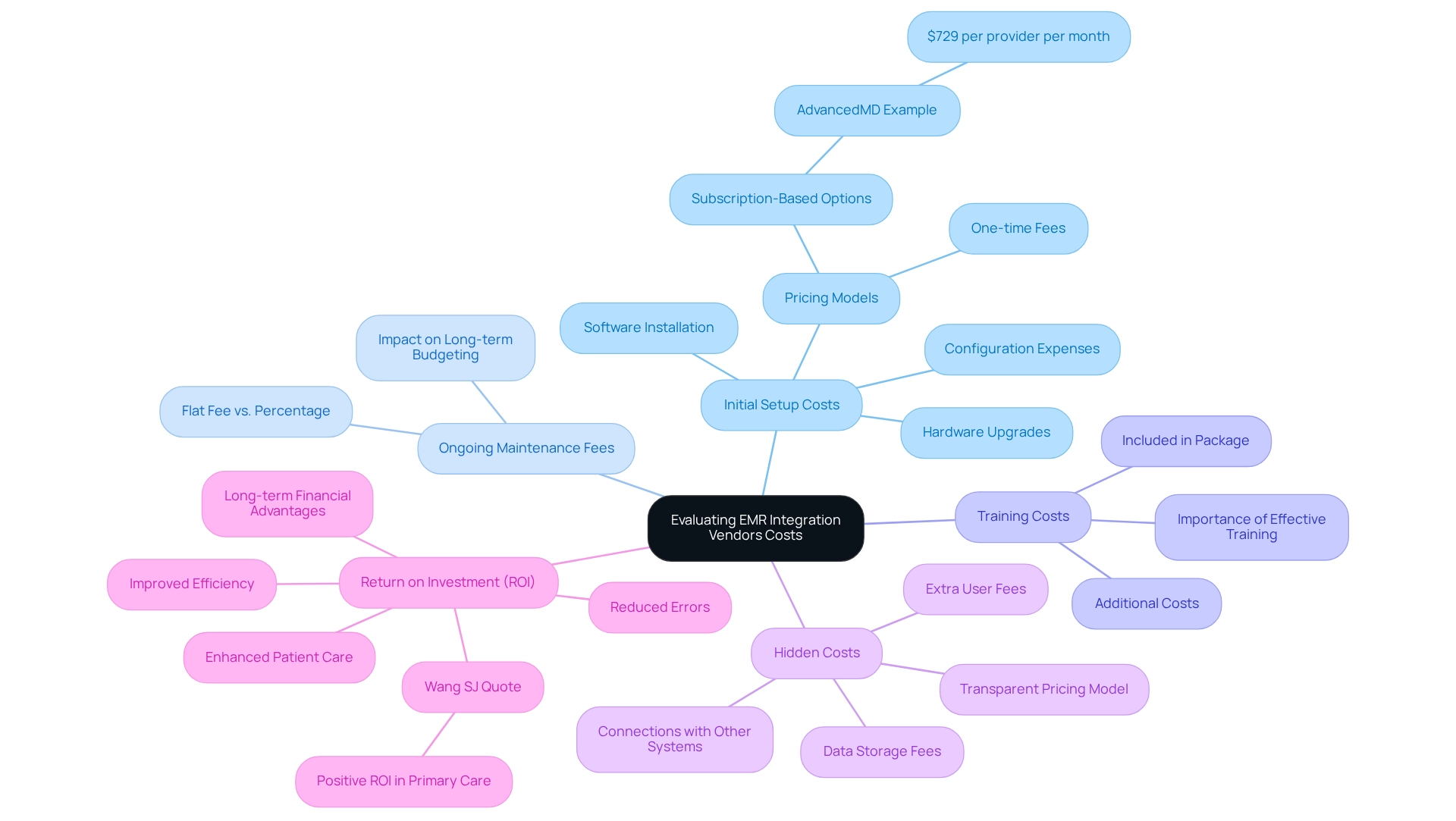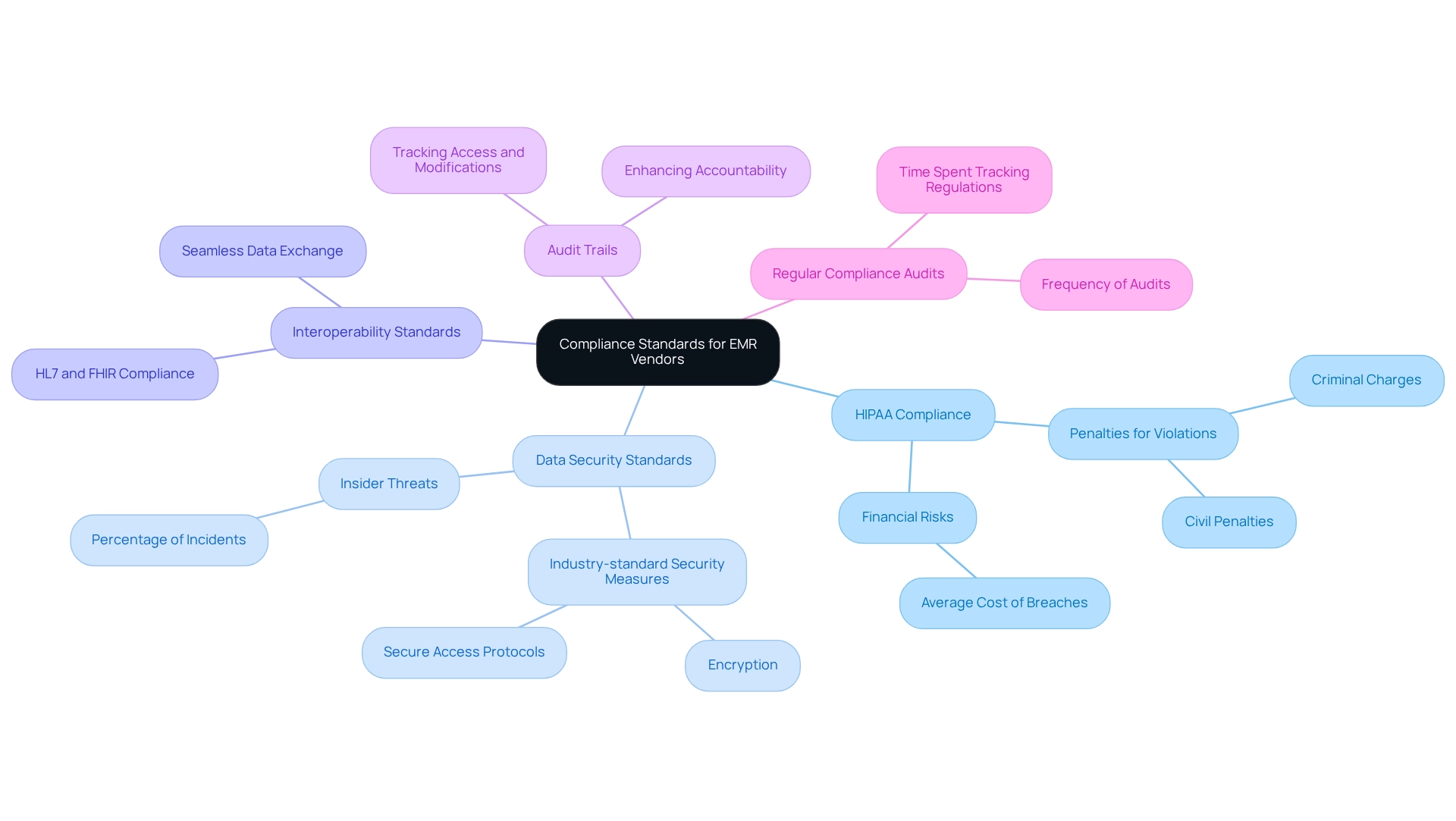Overview
Choosing the right EMR integration vendor is not just a decision; it’s a critical factor that can make or break your healthcare operations. We understand that:
- Interoperability
- Real-time data access
- User experience
- Security
- Scalability
- Ongoing support
are essential for effective data management and patient care. By prioritizing these features, we ensure seamless integration and compliance with regulatory standards. As a result, you can expect improved operational efficiency and better health outcomes. What’s holding your team back from achieving this level of excellence? Let us guide you in making informed choices that will elevate your healthcare delivery.
Introduction
In the rapidly evolving landscape of healthcare technology, we recognize that the integration of Electronic Medical Records (EMR) systems is a pivotal factor in enhancing patient care and operational efficiency.
As organizations navigate the complexities of data management and regulatory compliance, understanding the critical features of EMR integration becomes essential.
What challenges are holding your team back from achieving seamless data flow? From ensuring interoperability and real-time data access to prioritizing user experience and security, we must make informed decisions when selecting an integration vendor.
This article delves into the key considerations we should weigh, offering insights into:
- Cost factors
- Compliance standards
- The importance of vendor reputation in achieving successful integration outcomes
By focusing on these elements, we can streamline our operations and ultimately improve patient outcomes in a competitive environment.
Understanding EMR Integration: Key Features to Consider
When evaluating EMR integration vendors, we must prioritize several key features to ensure effective interoperability and data management.
- Interoperability: The capability of our EMR system to communicate and exchange data with other systems is essential. Our Hybrid Integration Platform excels in this area, enabling seamless data flow across various platforms, which is critical for enhancing patient care and operational efficiency.
- Real-Time Data Access: Solutions must allow providers to access patient data instantly. Our platform provides real-time monitoring and alerts on system performance, facilitating timely decision-making vital for improving patient outcomes. Recent advancements in real-time data access have shown that organizations leveraging these features can significantly enhance their responsiveness to patient needs. As business and medical writer Elsier Otachi highlights, “The ultimate aim is to enhance value through information exchange, which is essential for achieving improved health results.”
- User Experience: A user-friendly interface is crucial for minimizing training time and boosting staff productivity. Our unification streamlines workflows instead of complicating them, guaranteeing that medical professionals can concentrate on patient care. We are dedicated to architecting technology foundations that prioritize user experience in our integration solutions.
- Security Features: Given the sensitive nature of medical data, robust security measures—including encryption and access controls—are non-negotiable. Our platform is built with security as a priority, tackling the heightened cybersecurity threats encountered by medical entities. In 2022, medical entities reported heightened cybersecurity risk mitigation efforts, with only 34% showing confidence in their cybersecurity practices. This underscores the importance of these features in safeguarding patient information.
- Scalability: The selected solution must be able to expand alongside our entity, accommodating rising data volumes and extra functionalities as required. Our Hybrid Integration Platform is built to maximize and extend the value of legacy systems, ensuring adaptability in a landscape where healthcare demands are continually evolving. Furthermore, it considerably lowers expenses, rendering it a financially feasible choice for companies.
- Support and Maintenance: Ongoing vendor support is crucial for troubleshooting and ensuring compliance with evolving regulations. As healthcare entities encounter challenges like high turnover rates—reported at 25.9% in 2022—having dependable support can reduce some operational pressures. Our group of connectivity specialists is committed to providing outcomes and can play a crucial part in alleviating workload strains on personnel through efficient interoperability solutions.
By concentrating on these characteristics, we can more effectively evaluate which EMR integration vendors will successfully meet our requirements and enhance our operational efficiency, ultimately resulting in better health outcomes.
Evaluating Costs: A Comparative Analysis of EMR Integration Vendors
When evaluating EMR integration vendors, we must consider several critical cost factors that can significantly influence our decision-making process:
- Initial Setup Costs: These encompass expenses related to software installation, configuration, and necessary hardware upgrades. Vendors may present various pricing models, including one-time fees or subscription-based options. As we look ahead to 2025, average initial setup expenses for EMR integration vendors can vary significantly, influenced by the selected platform and our specific organizational needs. For instance, AdvancedMD operates on a subscription model, with prices starting at approximately $729 per provider per month, which can serve as a benchmark for our budgeting.
- Ongoing Maintenance Fees: Regular maintenance is vital for system updates and support. We should evaluate whether the supplier charges a flat fee or a percentage of total expenses each year. Understanding these fees is crucial, as they can impact our long-term budgeting and financial planning.
- Training Costs: Effective training is essential for maximizing the potential of the EMR system. We must evaluate whether the vendor includes training in their package or if it incurs additional costs. Investing in comprehensive training can lead to better utilization of the system and improved outcomes.
- Hidden Costs: We should remain vigilant for possible concealed expenses, such as fees for extra users, data storage, or connections with other systems. A transparent pricing model is preferable to avoid unexpected expenses that could strain our budgets. The case study titled “Key Factors Impacting EHR Pricing” highlights how various factors influence EHR implementation costs, emphasizing the importance of thorough budgeting.
- Return on Investment (ROI): We must consider the long-term financial advantages of the incorporation, including improved efficiency, reduced errors, and enhanced patient care. As observed by Wang SJ, “Implementation of an electronic medical record system in primary care can lead to a positive financial return on investment for the health care entity.” These factors can significantly offset initial costs, making the incorporation a worthwhile investment.
By carefully assessing these cost factors, we can choose from various EMR integration vendors that fit our budgetary limitations while ensuring a strong return on investment.

Compliance Standards: Assessing Vendor Adherence to Regulatory Requirements
When we evaluate EMR integration vendors, it is essential to prioritize adherence to regulatory standards. Compliance with key areas is non-negotiable:
- HIPAA Compliance: Our vendors must demonstrate strict adherence to the Health Insurance Portability and Accountability Act (HIPAA), which establishes rigorous guidelines for protecting patient information. Violations can lead to severe penalties, including fines ranging from $50,000 to $250,000, with civil penalties that can reach up to $1,500,000 per violation. This highlights the critical nature of compliance. Moreover, breaches cost nearly $220,000 more on average when noncompliance is indicated as a factor, underscoring the financial risks associated with inadequate compliance.
- Data Security Standards: It is vital that our vendors employ industry-standard security measures, such as encryption and secure access protocols, to protect sensitive data. Notably, 22% of all medical cybersecurity incidents stem from insider threats, which emphasizes the need for robust security practices.
- Interoperability Standards: Adherence to interoperability standards, such as HL7 and FHIR, is essential for ensuring that the EMR system can effectively communicate with other medical systems. This facilitates seamless data exchange and enhances patient care.
- Audit Trails: Maintaining detailed audit trails is crucial for tracking access and modifications to patient data, a requirement under many regulatory frameworks. This capability not only supports compliance but also enhances accountability within our organization.
- Regular Compliance Audits: We must evaluate if our suppliers undergo regular compliance audits and can provide documentation to demonstrate adherence to relevant regulations. With 62% of compliance officers spending 1 to 7 hours weekly tracking regulatory developments, it is clear that ongoing compliance is a significant commitment. Selecting EMR integration vendors who emphasize frequent audits can assist in guaranteeing that compliance standards are consistently upheld.
By confirming that our EMR integration vendors adhere to these compliance standards, we can efficiently reduce risks linked to data breaches and regulatory fines, ultimately protecting patient information and preserving trust. Furthermore, the repercussions of noncompliance extend beyond financial penalties, potentially resulting in considerable reputational harm, which we must take into account when choosing our EMR collaboration partners.

Key Takeaways: Choosing the Right EMR Integration Vendor for Your Needs
Selecting the right EMR integration vendor requires a strategic approach, focusing on several essential factors that we must consider:
- Key Features: Interoperability, real-time data access, user experience, security, scalability, and strong supplier support are not just buzzwords; they are crucial for ensuring seamless integration and optimal performance within medical systems. As the client-server-based EHR segment continues to grow due to its customization capabilities and enhanced security features, we see companies increasingly prioritize providers like Avato. They deliver tailored solutions designed for secure transactions across sectors such as banking, healthcare, and government. Our hybrid connection platform supports 12 levels of interface maturity, enabling organizations to balance connection speed with the sophistication required to future-proof their technology stack.
- Cost Evaluation: A comprehensive analysis of initial setup costs, ongoing maintenance fees, training expenses, and potential hidden costs is essential. Notably, only 30% of the challenges in India are linked to the cost-effectiveness of deploying EHR systems. This indicates that organizations must also focus on other elements, such as supplier assistance and system flexibility, to ensure successful integration. Our hybrid integration platform is architected to provide a cost-effective foundation for digital transformation initiatives.
- Compliance Standards: We must ensure that our supplier adheres to HIPAA and other pertinent regulations. This adherence is vital for protecting patient data and minimizing legal risks, which are paramount in the healthcare sector. Avato’s commitment to secure transactions positions us as a trusted partner in maintaining compliance and safeguarding sensitive information.
- Supplier Reputation: It is imperative to examine provider feedback and testimonials to assess their reliability and efficiency in delivering connection solutions. A strong reputation often correlates with successful project outcomes and customer satisfaction. As Tony LeBlanc from the Provincial Health Services Authority noted, “Good team. Good people to work with. Extremely professional. Extremely knowledgeable.” This underscores the importance of supplier support in achieving efficient patient care and highlights our commitment to delivering results through our hybrid connection platform.
By focusing on these essential takeaways, we can confidently choose EMR integration vendors that meet our operational needs and regulatory requirements. Furthermore, with organizations like King’s College Hospital upgrading their electronic medical records system using advanced solutions such as Oracle Cloud services, it is evident that the demand for effective integration solutions is on the rise. Ultimately, a well-informed choice can lead to improved care coordination and patient outcomes, as highlighted by industry leaders.
Conclusion
In the pursuit of enhanced patient care and operational efficiency, we recognize that the integration of Electronic Medical Records (EMR) systems is a critical factor. This article has underscored the essential features we must consider when selecting an EMR integration vendor:
- Interoperability
- Real-time data access
- User experience
- Security
- Scalability
- Ongoing support
Each of these elements is vital in ensuring that healthcare systems function seamlessly and adapt to evolving demands.
Cost evaluation is another key aspect that we cannot overlook. A thorough analysis of initial setup costs, ongoing maintenance fees, and potential hidden expenses is crucial for making a financially sound decision. By focusing on the return on investment and the long-term benefits of EMR integration, we can better align our budgetary constraints with our operational goals.
Compliance with regulatory standards, particularly HIPAA, is paramount in safeguarding patient data and avoiding the severe penalties associated with noncompliance. We must prioritize vendors that demonstrate a commitment to meeting these standards, thereby mitigating risks and enhancing trust in our data management practices.
Ultimately, our choice of an EMR integration vendor can significantly influence the quality of patient care and operational success. By concentrating on the key features, cost factors, and compliance requirements outlined in this article, we can make informed decisions that lead to enhanced care coordination and improved patient outcomes in an increasingly competitive landscape. The right integration partner can transform our approach to healthcare delivery, ensuring that we are well-equipped to meet both current and future challenges.

